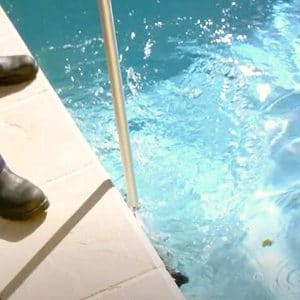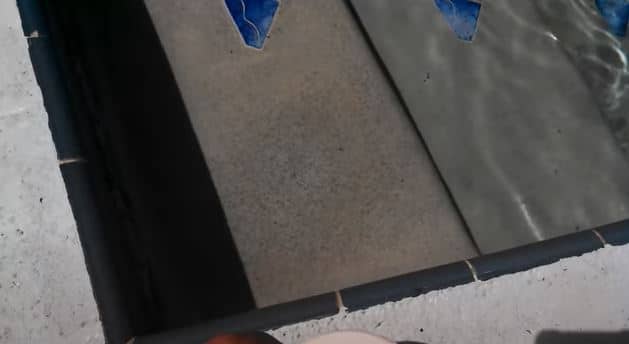Have you installed a dazzling swimming pool in your yard? You would always want it to look like a piece of paradise to knock your neighbor’s socks off!
Keeping the wading pool clean will give it a glazing effect which will leave its viewers awestruck. But how many people know to clean a swimming pool properly?
Cleaning a bathing pool with expensive bells and whistles is going to be tough enough. Hence why many owners can’t help the pool to carry its rustic charm for long.
Moreover, a swimming pool that isn’t uncluttered in a proper way can be hazardous for you and your kids’ health. So now you know how important it is to clean up your swimming pool, don’t you?
If you’re wondering how to fix one’s glaze at your pool and keep it non-toxic for your family then we’re here for the rescue. You may need some special equipment or solutions to clean a pool properly but don’t worry as they are easily accessible.
Let’s learn how to clean a green pool in a simple way before you roll up your sleeves..
How To Clean A Green Pool In A Simple Way
The easiest way to keep your pool free of algae is to spend a few moments each day taking care of it. Here is a step-by-step guide for you to clean up your pool easily and steadily.
The first thing you should do is to look for algae and debris in your pool. For algae growth, you can sweep them away to stop the growth. If there are dirt and debris in water then try using a net bag to take them out of there.
Now you have to check the chlorine levels in the water. You may notice a very strong chlorine scent and the swimmers would come red-eyed from the pool when the level is too high. On the other hand, you might get a chemical scent around the pool when the chlorine level is too low.
To fix the chlorine level, if the level is too low then simply add more chlorine in the water. You’ll find it in tablet or granular, liquid shock, and powder shock form. They’ll increase the chlorine level immediately in the water.
Reducing the chlorine level in your pool can be a lot more troublesome. Leave your pool uncovered and direct in sunlight and it’ll help you by reducing the chlorine level.
Sunlight and heat can eat up chlorine thus reducing chlorine in your pool. This is the reason why owners keep testing the level more often on warmer days. Swimming pool water tends to turn green in summer due to the lack of chlorine. You can also reduce the level by draining some of the existing pool water and then adding new water to it.
Skimmer nets collect leaves and debris from the pool and prevent them from going into the plumbing lines. Make sure you’re checking the skimmer nets every morning and getting them cleaned.
If your pool water becomes cloudy or green then you better have a check on your pool sand filter. A sand filter works by filtering oil, dirt, and debris of the water, making the water clearer.
But after a few times of vacuuming the pool water, the pool sand filter gets full of dirt. Hence, it can not filter water properly and pool water does not look clearer like it used to. So, it’s very important to backwash the pool filter when it doesn’t work as it should.
Next comes the pH level of the pool water. If the pool water pH level isn’t accurate then no chemicals can work properly in it. If the pH level gets higher than 7.8 then it will reduce the effectiveness of the chlorine.
This can also cause cloudy water, skin rashes, and many more. If the pH level drops too low, it makes the swimmer’s eye-stinging and skin itching. So now you know how important it is to maintain a proper level of water pH.
To increase the pH level of the pool, either add sodium carbonate or sodium bicarbonate in the water. It’s best to keep the level between 7.2 to 7.8. On the contrary, when you tested the pH level and it came too high, you have to reduce the level.
Two chemicals are used vastly to reduce the pH level in the water and these are sodium bisulfate which is also known as dry acid, the other one is muriatic acid. Add any of these chemicals to your pool according to the instructions that come with the acid package. Avoid using these on windy days and wear protective gears while using these.
Now that you know how to fix green/cloudy pool water, it’s time to learn how to clean the green pool walls and equipment. Let’s jump right in?
How To Clean Green Walls And Equipment
It’s not as easy to clean the walls and equipment as easy it was to clean the green pool water.
You have to drain all of the water and start scrubbing the walls in order to get the pool cleaned and get it a charming effect.
Firstly, clean out any dirt or debris by using net bags. Clean the dirt from skimmers and put on new nets.
You need some cleaning equipment like brushes and scrubbers to clean the algae attached to the walls. Better use some cleaning liquids so that you get a cleaner surface by the end.
See if there’s any debris on the bottom of the pool. Clean them with the use of a vacuum cleaner designed for pool cleaning. And if you already have a garden hose, you can try to make a pool vacuum using the hose.
Get the built-in pump filter cleaned. The pool filter keeps your pool water clean by removing algae, debris, hairs, dirt, oils from the pool.
The pool filter eventually gets clogged with this dirt. So it can’t clean the water properly. People use trisodium phosphate or muriatic acid to clean pool filters. Make sure you’re wearing protective gear while cleaning.
Pool sand filters use natural sand to filter dirt and debris. It traps debris and provides clean water to the pool. After a certain period, you need to clean the pool sand filter. Check your sand filter’s reading of the pressure, when it reaches 8-10 pounds then you will have to clean the sand filter by using the backwash cleaning system.
You might have to change the sand once in 5-7 years. Though it’s not that difficult but quite time-consuming which depends on the size of the canister your sand filter has in it.
Add chlorine or non-chlorine chemicals to the pool as a shock treatment. This will increase the free chlorine level in your pool. You have to raise the level to a number that will destroy contaminants like algae, bacteria, and chloramines in the water.
Make sure the pH level is set between 7.1 and 7.3 because that’s when the shock treatment is most effective. 10-30 ppm of chlorine is needed as per the density of the algae.
Flocculant is a method that is being used to improve the filtration of a pool. This makes things easier for the filter to clean and disinfect the water properly. This treatment is applied when your filter struggles to eliminate floating particles efficiently.
This treatment works by clumping all the small invisible particles together in a big piece of a group which is filtered by the pool filter later on. Check if the pH is accurately balanced for the treatment to work properly.
It’s not recommended to use flocculant if yours is a diatom filter as it might clog the filter. There are cartridge flocculant, liquid flocculant, and tablet flocculant available that you can use for your pool. Read the instructions on dosage before you apply it.
As the last step, backwash the sand filter for another time with a 12 hours gap. Check if the skimmer nets got clogged with dirt or algae and replace them if needed.
How Stains Develop In A Pool Liner
You have to understand the root cause of the stain that you’re trying to eliminate from the pool liner. Once you find out the reason for the stains, it’s now easier to prevent them from occurring again and again. Let’s find out their usual causes…
Teal Colored Stains: This color of stains are usually caused by copper issues. These stains could be arising from pipes. This can also occur with the pool heater as a result of inadequate chemical maintenance.
Red To Brown Stains: These Stains are typically formed by the iron in a pool. Sometimes they can be seen in stained yellow. These rusty flakes on the pool liner come from metals, iron pipes, or unfiltered well water.
Green To Brown: Green to brown stains come from dirt like algae, bugs, leaves, and mud. Green or cloudy algae water also stains the pool liners.
Red, Pink, Or Purple Stains: These colors come from different types of fruits that fall in the pool if you have nearby trees. Sometimes these colors also indicate bacterial growth in your pool.
Black Stains: This color isn’t very common in pools but does exist. This comes from a kind of metal called manganese which enters the pool with well water.
How To Clean Organic Stains From Pool Liners
Some organic stains are difficult to remove than most organic stains but these are a lot easier to deal with than metal stains. Let’s find out how to remove organic stains from pool liners…
- Clean the pool by removing visual dirt and debris. Clean the pool filter nicely.
- Take a brush with a soft bristle and start brushing the area with stains and algae. This will help the stains and algae to loosen.
- If the pool surface has a lot of dirt, debris and leaves then use a vacuum designed for this purpose.
- Be sure that the chemicals are accurately balanced. Check the levels by testing the pool water and adjust the chemistry.
- Apply shock treatments to the pool and it’ll be easier for the stains to erase easier. Brush those stains right after the shock treatment.
How To Clean Metal Stains From Pool Liners
Certainly, removing metal stains is going to be way too tough and time-consuming than organic stains. You have to keep your water pH level properly balanced to avoid such problems.
A pool with low or high pH levels can create more stains in the pool. Test kits to check for minerals or metals aren’t very accurate. But you can ask your local pool service center to do the job for you.
Now let’s see how to remove metal stains from the pool….
- Clean your pool properly and check if the chemistry of the pool is balanced. If the chemistry isn’t properly balanced then it can make the stains worse and hard to eliminate.
- Test if your pool has metals in it by using a test kit. If this confirms that there’s any metal present then remove the metals with the use of a metal sequester.
- Find out what’s causing the stains and fix the issue. You might have to change the water source, replace rusted ladders, or fix faulty pipes.
- To prevent such issues from happening in the future, keep testing for metals in the pool, keep your water chemistry balanced, and use metal sequesters.
Final Thoughts
Keeping a swimming pool clear, healthy, and beautiful can be quite backbreaking but in the end, it’s completely worth it.
You won’t have to spend much effort or time cleaning a pool if you maintain it properly on a regular basis. This will not only give it a luscious look but also keep your kids and all other swimmers healthy.


